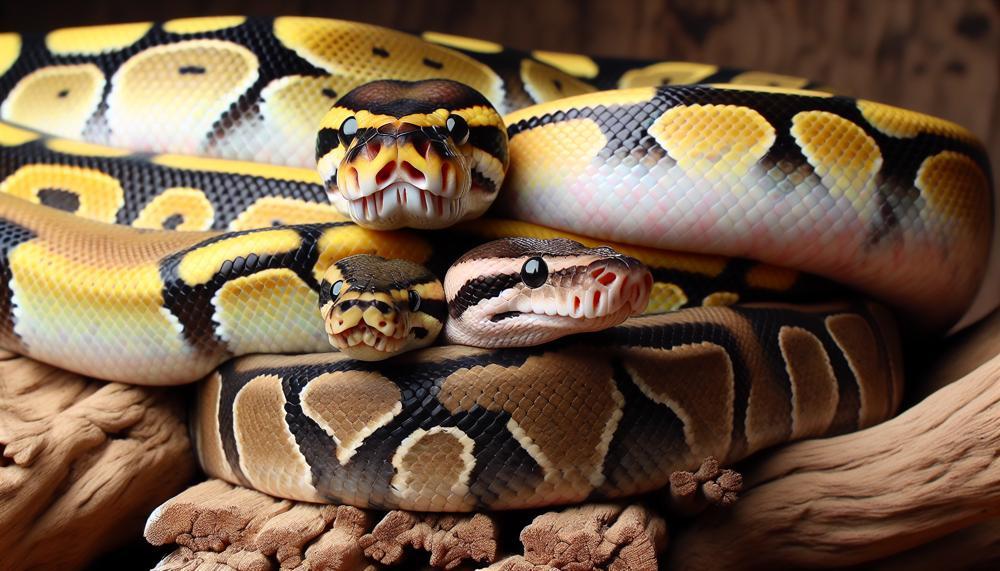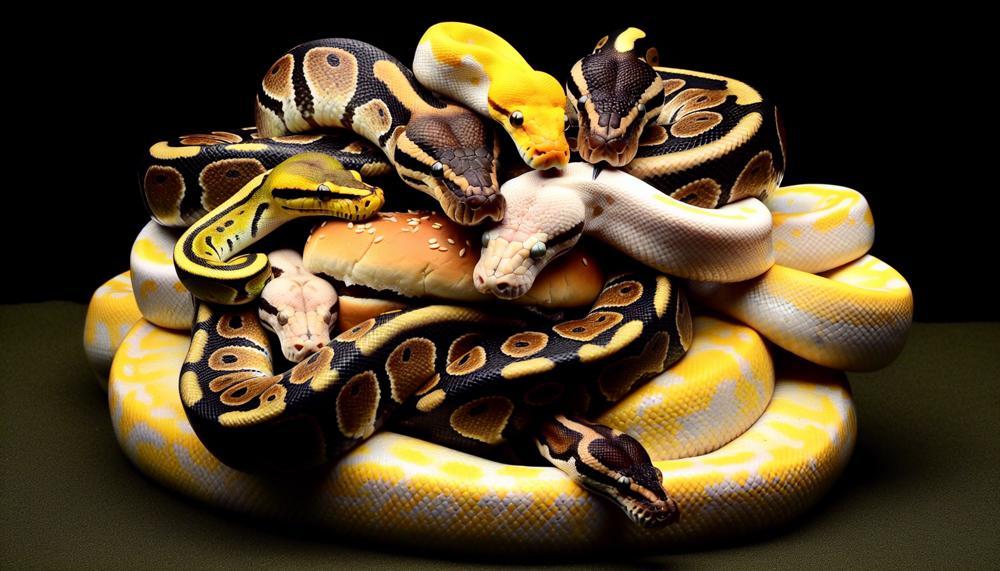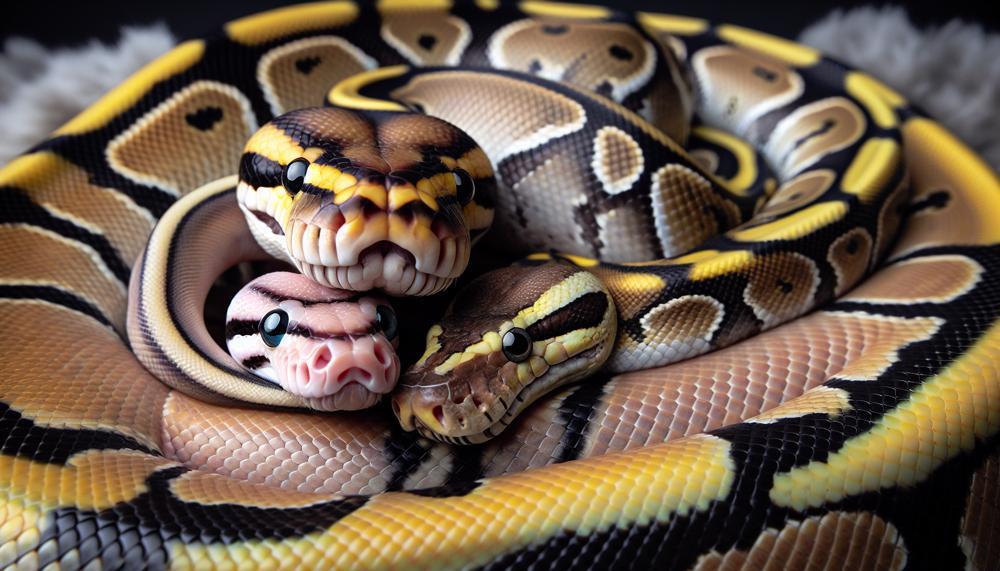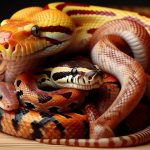Today, we’re delving into the captivating world of ball pythons and their constricting prowess. These serpentine creatures may appear gentle and charming, but don’t be deceived; they possess a lethal hunting technique that will leave you spellbound. Here’s what you need to know:
- Ball pythons are renowned for their ability to constrict their prey, suffocating them with powerful coils.
- This behavior serves not only as a means of catching food, but also as a defense mechanism against predators.
- Despite their name, ball pythons do not actually curl up into a “ball” when constricting – instead, they use strategic pressure points to immobilize their prey.
- With their muscular bodies and sharp teeth, these snakes are skilled hunters of small mammals and birds.
- While some may find this behavior intimidating, it is completely natural for ball pythons and essential for their survival in the wild.
So, buckle up and prepare to be mesmerized by the incredible constricting abilities of these alluring creatures.
Trust us, by the end of this post, you’ll be hissing with excitement.
Let’s slither our way into it.
Contents
- 1 Ball Python Physical Characteristics
- 2 Natural Behavior of Ball Pythons
- 3 Are ball pythons constrictors?
- 4 Ball Python Behavioral Adaptations
- 5 Understanding Ball Python Behavior in Captivity
- 6 Common Ball Python Behavior Issues
- 7 Tips for Maintaining Healthy Ball Python Behavior
- 8 Ball Python Facts
- 9 Conclusion
Ball Python Physical Characteristics
When it comes to their hunting abilities, ball pythons are well-equipped with physical characteristics that are specifically adapted to aid in their constriction abilities. Their strong and stout bodies allow for impressive strength and power when climbing and constricting, while their prehensile tails provide balance and support during these activities.
Additionally, their specialized eye structure grants them excellent depth perception and low-light vision, making it easier for them to accurately target prey.
But perhaps one of the most fascinating physical characteristics of ball pythons is their heat-sensing pits. These unique sensory organs allow them to locate warm-blooded prey, even in complete darkness.
Furthermore, their columellae, or inner ear organs, enable them to perceive low-frequency sounds and vibrations, helping them detect potential threats or opportunities in their environment.
In addition to these specialized features, ball pythons also exhibit certain behaviors that aid in their constriction abilities. For instance, they have a “balling behavior” where they coil into a tight coil as a defensive mechanism, which also assists in efficiently constricting prey. Their countershading coloration serves as camouflage for hunting and avoiding predators.

Natural Behavior of Ball Pythons
Ball pythons in the wild have a unique hunting technique that involves patiently waiting and striking at their prey unexpectedly. They use both visual and chemical cues to locate their target, relying on their heavy bodies to move quietly and undetected.
Once their prey is identified, they strike quickly and use constriction to subdue and kill it. This method of hunting has proven highly effective for ball pythons, allowing them to catch a wide variety of prey without the need for venom or fangs.
| Method | Characteristics | Effectiveness |
| Ambush | Wait and strike quickly | Highly effective |
| Visual cues | Rely on eyesight to locate prey | Effective |
| Chemical cues | Use scent to track prey | Effective |
| Constriction | Suffocate prey with body coils | Highly effective |
In addition, ball pythons are notorious for swallowing their prey whole, often while it is still alive. This is possible due to their flexible jaw structure, which allows them to stretch their mouths wide enough to consume prey much larger than themselves.
This method of hunting also allows them to conserve energy, as they do not have to chase down or expend energy on killing their prey.
Furthermore, ball pythons have evolved specialized eye structures and heat-sensing pits that aid in locating prey in low-light or obscured conditions. These physical characteristics give them an advantage when hunting and make them highly efficient predators.
Despite primarily being ambush hunters, ball pythons have also been observed actively searching for food, using their strong sense of smell to track prey.
This behavior is more commonly seen in younger ball pythons who are still developing their hunting skills and learning the ropes.
Are ball pythons constrictors?
Yes, ball pythons can make you feel tight. If they wrap their bodies around their prey and squeeze them until they choke, they have killed them.
Ball pythons are snakes that live in West and Central Africa. They are not poisonous. They grow to be about 182 cm (72 in) long, making them the shortest of the African pythons. A lot of people keep them as pets because they are easy to take care of and don’t bother people.
Another group of constrictors is this one:
- Asian python, Burmese python, Indian python, Reticulated python, and Anaconda.
- You can find constrictors all over the world. They come in many shapes. The reticulated python, which can get up to 30 feet long, is the biggest constrictor.
Ball Python Behavioral Adaptations
Ball pythons possess a diverse range of behavioral adaptations that contribute to their exceptional ability to constrict their prey.
These adaptations enable them to effectively hunt and consume larger prey, making them highly efficient predators in their natural habitat.
The primary behavioral adaptations of ball pythons include their nocturnal behavior, patience, and stealth.
Nocturnal Behavior:
Ball pythons are primarily active during the night, allowing them to avoid predators and hunt when their prey is most active.
This behavior also helps them conserve energy during the day, as they are ambush predators and do not actively seek out prey.
Patience:
In terms of hunting technique, ball pythons have a unique approach where they patiently wait for their prey to come within striking distance.
This patience enables them to conserve energy and only utilize it when necessary, making them highly skilled hunters.
Stealth:
In addition to being patient, ball pythons also possess remarkable stealth capabilities.
They utilize their natural camouflage to blend in with their surroundings and remain undetected by potential prey. This allows them to get close enough to strike without being noticed.
Constriction:
The most well-known behavioral adaptation of ball pythons is their exceptional ability to constrict their prey. This involves tightly wrapping their body around their prey and squeezing until the prey suffocates. Their muscular body structure and strong grip enable them to effectively constrict even larger prey.
Overall, the combination of these behavioral adaptations allows ball pythons to effectively hunt and consume prey much larger than themselves, making them successful predators in the wild. In captivity, it is crucial to recreate a similar environment and provide proper care for these behavioral adaptations to continue thriving.
Moreover, these behavioral adaptations have evolved over time through natural selection and have been passed down from generation to generation. This process has allowed ball pythons to adapt and thrive in their environment, showcasing the incredible diversity of nature’s creations.
Understanding Ball Python Behavior in Captivity
Ball pythons display various behaviors in captivity, including hiding, basking, and hunting. However, there are significant differences in their behavior when compared to their wild counterparts. These differences stem from the varying environments and resources available to them, as well as their feeding schedule and competition for resources.
It is crucial for snake owners to acknowledge and adapt to these differences in order to provide optimal care for their pets.
While ball pythons may exhibit similar behaviors in captivity and in the wild, the circumstances surrounding these behaviors can differ greatly. For example, in captivity, ball pythons may have access to a limited range of environments and resources compared to the vast and diverse habitats available in the wild. This can result in different feeding patterns and hunting techniques for captive snakes.
In contrast to the wild, where they must hunt and compete for food, ball pythons in captivity frequently have control over their feeding schedule. This can lead to differences in their behavior, such as decreased activity levels and reduced hunting instincts.
As such, it is essential for snake owners to provide appropriate enrichment activities and feeding schedules that mimic a more natural environment.
Understanding these differences in behavior between captive and wild ball pythons is crucial for providing proper care for these reptiles.
Common Ball Python Behavior Issues

Some common issues that ball pythons may exhibit include shedding problems, injuries from live prey or heat lamps, skin sores, respiratory diseases, dental disease, parasites, and a lack of UV light exposure.
These issues can result in infections, weight loss, and other health problems if not addressed properly.
Therefore, it is crucial for owners to provide a suitable habitat with appropriate heating, humidity levels, and hiding spots for their ball pythons to prevent these issues.
Avoid using live prey to prevent injuries during feeding
Use a thermostat to regulate heat lamps and prevent burns
Clean and disinfect any wounds to prevent infection
| Behavior Issue | Signs and Symptoms | Treatment/Prevention |
| Problems with Shedding | Difficulty shedding, skin stuck on body | Provide a humid hide with damp substrate to aid in shedding Offer regular baths to help loosen skin Make sure humidity levels are maintained in the enclosure |
| Injuries from Live Prey or Heat Lamps | Burns or open wounds on the body | |
| Skin Sores | Redness, swelling, or open sores on skin | Maintain proper humidity levels in the enclosure Keep the enclosure clean and free from bacteria Consult a veterinarian if sores do not heal or worsen |
| Respiratory Diseases | Difficulty breathing, wheezing, or discharge from the nose or mouth | Ensure proper ventilation in the enclosure Keep the enclosure clean to prevent bacteria growth Consult a veterinarian for antibiotics and other treatment options |
| Dental Disease (Stomatitis) | Difficulty eating, swollen gums, bad breath | Provide a varied diet to promote good dental health Offer a calcium supplement to prevent dental disease Consult a veterinarian for proper treatment and pain management |
| Parasites | Weight loss, diarrhea, visible worms in feces | Deworm ball pythons regularly Keep the enclosure clean and sanitized Consult a veterinarian for proper medication and treatment |
| Lack of UV Light Exposure (Metabolic Bone Disease) | Weakened bones, difficulty moving, lack of appetite |
Tips for Maintaining Healthy Ball Python Behavior
Ball pythons, like all living creatures, can experience health issues that require attention and care. As a responsible owner, it is important to be aware of the signs of unhealthy behavior in ball pythons and take preventive measures to ensure their overall well-being. Here are some common signs of unhealthy behavior in ball pythons and how they can be prevented.
| Signs of Unhealthy Behavior | Preventive Measures |
|
|
|
|
|
|
|
|
| Obesity or anorexia |
|
Aside from these signs, regularly monitoring your ball python’s overall appearance and behavior is crucial. A healthy ball python should have clear eyes, smooth skin, and be alert and active. Any changes in these areas could indicate a health issue and should be addressed promptly.
Ball Python Facts
All ball pythons are known for being constrictors, and there are no exceptions to this rule. As discussed in the previous section, all types of pythons, including ball pythons, possess natural constricting abilities and do not have any venom.
This means that they lack fangs or other structures used for delivering venom and instead rely on suffocation as their primary method of killing prey.
To further emphasize this point, it is crucial to differentiate between constrictors and venomous snakes. Although both types of snakes use different techniques to hunt and kill their prey, the key difference lies in how they deliver the fatal blow.
As mentioned earlier, constrictors use their powerful body muscles to squeeze and suffocate their prey, while venomous snakes inject venom through their fangs to paralyze their prey.
Conclusion
In conclusion, ball pythons are renowned for their impressive constricting abilities, making them one of the most skilled hunters in the reptile world.
With their muscular bodies, specialized eye structures, and heat-sensing pits, these serpentine creatures have evolved to be highly efficient predators in the wild. Their unique hunting technique not only serves as a means of catching food but also acts as a defense mechanism against predators.
Despite their name, ball pythons do not actually curl up into a “ball” when constricting. Instead, they use strategic pressure points to immobilize their prey—a natural and essential behavior for their survival in the wild.
In captivity, it is crucial to provide proper care and enrichment activities to maintain these natural behaviors and ensure the well-being of our pet pythons.
While some may find their constricting prowess intimidating, it is important to understand that this behavior is instinctual and necessary for their survival.
Through natural selection and evolution, ball pythons have developed physical characteristics and behavioral adaptations that make them highly successful hunters. This makes them fascinating creatures to observe and care for.
As responsible owners, it is important to be aware of common behavioral issues that can arise in ball pythons and take preventive measures to ensure their overall well-being. By understanding the natural behavior of these captivating creatures, we can better appreciate and care for them as pets.






